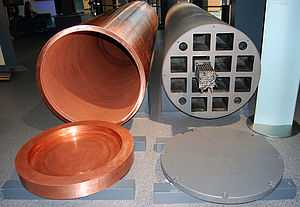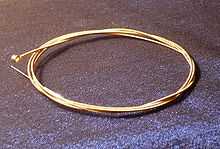Phosphor bronze
Phosphor bronze (sometimes sold with the shorter name Phos Bronze) is an alloy of copper with 3.5 to 10% of tin and a significant phosphorus content of up to 1%. The phosphorus is added as deoxidizing agent during melting.
These alloys are notable for their toughness, strength, low coefficient of friction, and fine grain. The phosphorus also improves the fluidity of the molten metal and thereby improves the castability, and improves mechanical properties by cleaning up the grain boundaries.
Industrial uses
Phosphor bronze is used for springs, bolts and various other items used in situations where resistance to fatigue, wear and chemical corrosion are required (e.g., a ship's propellers in a marine environment). The alloy is also used in some dental bridges.
Grades A, C and E – C51000, 52100, 50700 are commonly used nonferrous spring alloys. The combination of good physical properties, fair electrical conductivity and moderate cost make Phosphor Bronze round, square, flat and special shaped wire desirable for many springs and electrical contacts and a wide variety of wire forms where the desired properties do not require the use of more expensive Beryllium copper. [1]
Phosphor Bronze (94.8% copper, 5% tin, 0.2% phosphorus) is also used in cryogenics. In this case its combination of fair electrical conductivity, and low thermal conductivity allows the making of electrical connections to devices at ultra low temperatures without adding excessive heat.[2]
Spent nuclear fuel overpack

Oxygen-free copper can be alloyed with phosphorus (CuOFP alloy) to better withstand oxidizing conditions. This alloy has application as thick corrosion-resistant overpack for spent nuclear fuel disposal in deep crystalline rocks.
Musical instruments

Phosphor bronze is preferred over brass for cymbals because of its greater resilience, leading to broader tonal spectrum and greater sustain.
Phosphor bronze is one of several high copper content alloys used as a substitute for the more common "yellow" or "cartridge" types of brass to construct the bodies and bells of metal wind instruments. Examples of instruments constructed using high copper alloys occur among members of the brass instrument family (trumpets, flugelhorns, and trombones) and one member of the reed instrument family, saxophones. In addition to the distinctive appearance provided by the reddish-orange hue of high copper alloys, they are purported by some instrument designers, sellers, and players to provide a broader harmonic response spectrum for a given instrument design. The Yanagisawa 902/992 model saxophones (pictured) have bodies of phosphor bronze, in contrast to the brass 901/991 models.
Some instrument strings for acoustic guitars, mandolins and violins are wrapped with phosphor bronze. Some harmonica reeds are made of phosphor bronze, such as those by Buckeye Music and the Suzuki Musical Instrument Corporation.[3] Some snare drums are constructed with phosphor bronze.
Variants
Further increasing the phosphorus content leads to formation of a very hard compound Cu3P (copper phosphide), resulting in a brittle form of phosphor bronze, which has a narrow range of applications.
Around 2001, the Olin Corporation developed another phosphor bronze alloy[4] comprising:
- Zinc – 9.9%
- Tin – 2.2%
- Iron – 1.9%
- Phosphorus – 0.03%
- Copper – 85.97%
Olin developed this new alloy for use in electrical and electronic connectors. When assessed in strictly metallurgical terms it is not true phosphor bronze, but a form of iron-modified tin brass.
References
- ↑ "Little Falls Alloys". Retrieved 2009-05-08.
- ↑ "LakeShore". Retrieved 2011-12-23.
- ↑ http://www.suzukiharmonica.com/
- ↑ "Innovations: Phosphor Bronze: Teaching an Old Dog New Tricks". Copper.org. Retrieved 2010-03-20.